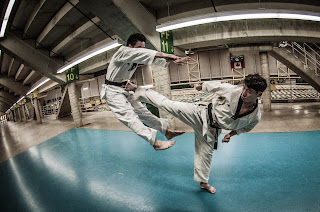"You can't prepare yourself for martial arts, but martial arts can prepare you for many things."
-Seyd Saidi
"Some things you have to do everyday. Eating seven apples on Saturday night instead of one a day just isn't going to get the job done."
-Jim Rohn
I've always been a bit dubious of reverse- kicks. Where one turns the body to deliver a blow.
My reasoning is simple; one should not ever turn one's back in a survival situation, and I tie everything practical to whether or not it would be effective in saving one's life or triumphing in combat.
That being said, they are cool moves. I wouldn't place them in the 'flashy' category (such as the scorpion-kick and its like)
...but they are pretty close to it. I have never seen a reason to use a reverse kick when simply doing that kick without the reverse would work just as functionally. It is possible because of the torque to generate more force in your strike, but moving forward into where you are striking as you kick can also achieve that result.
But either way, because I love the martial arts from the practical to the flashy, I try to learn everything, and so because it was a part of past curriculum, I still practice them today. One maneuver I am working on is to do a front-kick, and with the same kicking leg without putting it down to initiate a reverse side-kick from the first kick. It may not be practical, but its fun, and that is reason enough for me to practice something; and just because I practice it does not mean in the least it is something I intend to hone to a point I can rest my life on it if push came to shove.
So I'm not trying to dog or discourage others from using the kick, I just don't think that it's practicality, while versatile in sparring conditions, especially in those of Olympic style Tae Kwon Do such as when one does a roundhouse, does not apply to the streets.
In short, I do not fully trust the kick as much as I would the more straightforward and traditional.
That being said, the most preferential kicks I have for reverse kicking are that of the reverse side-kick, and the reverse axe-kick.
To me, any reverse kick is where one turns the body in a circular motion to deliver the kick.
There are countless variations and almost all the primary methods of kicking (front kick, side kick, axe kick, round-kick) can be utilitzed with the reverse.
But to execute a kick correctly, without losing balance and still hit one's target accurately can be considerably tricky.
Many do lose their balance and have to do a kind of hop to keep stabilized (very bad, because this means if you do impact your target you could knock yourself over because your balance is so tenuous when doing the kick) and even worse is if one entirely misses their target. No point in doing a strike if going to miss; it's wasted energy.
I made this video awhile back, but it describes how I would normally teach how to do a simple reverse kick to someone; namely focusing on the side-kick which can be the most problematic. (The hardest reverse-kick for me is doing a reverse round-house because one is kicking in a direction opposite of how one is turning.)
But no matter the kicks, my teacher who taught me Chung-Do Kwan had a simple formula for improving one's reverse kick. I really have yet to see it fail. You can see it in the above video, so I am essentially repeating myself, but the trick is worth it.
'Head-Shoulder-Hips'.
Simple, where your head goes your shoulders follow, and where your shoulders go, your hips as well.
Give it a try with your reverse kick. This works for any full rotational kick. Doing a back-kick (Also called a horse or donkey kick in some styles) does not necessarily apply. One uses a circular/arcing motion, whereas the 'back' style kick uses a swing like a lever to initiate the kick.
Like I said, there are many kicks which employ turning in a fashion where one exposes the back. I distrust all of them for the simple reason I espoused earlier.
Reverse kicks can be used also with jump-kicks;
Tornado Kick
Jump Reverse Hook-Kick
And so on.

No comments:
Post a Comment